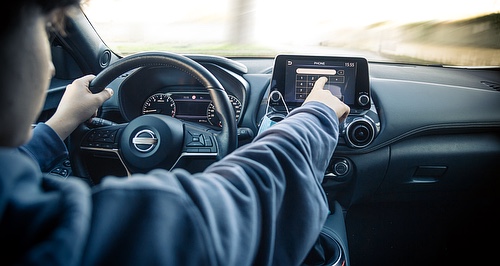News - General News - TechnologyExperts say in-car tech ‘too distracting’Need to remove driver distraction acknowledged, inattention a major contributor to accidents28 Jul 2022 NEW research from UK-based connectivity experts VNC Automotive suggests that driver distraction and inattention are considered factors in nearly half of all fatal and serious injury accidents.
The firm, which designs potentially less distracting in-car connectivity software currently in use in over 35 million vehicles globally – including in 20 of the worlds’ largest automotive OEMs – says many new cars are now so heavily laden with technology that the modern car interior is at risk of becoming as distracting as what is happening outside of the vehicle.
“Competition for driver attention has never been greater,” said VNC Automotive CEO Tom Blackie.
“The roads are busier than ever, touchscreens dominate vehicle interiors, and we’re living increasingly connected lives – that means there are now many more opportunities for a driver’s focus to be elsewhere.”
Not only that, but modern cars are full of systems keen to issue a cacophony of warnings and alerts, chastising us or actively intervening for straying over a white line without indicating, directing us to turn left or right at the next roundabout, or demanding we take a break when we’re kilometres from the nearest service area.
That’s to say nothing of the other major in-car distraction… the mobile phone, which continues to be too tempting for many drivers judging by police data on the number of fines (still) issued for illegal phone use.
“Many distracting in-car features have become the ultimate back-seat driver. Interrupting the task of driving to issue critique but with not enough context to be useful,” said Mr Blackie.
“It’s easy to see how we got here. Purely passive safety measures such as airbags and crumple zones have now reached the limit of their potential, with no further major developments expected.
“In addition, visibility has taken a back seat in favour of occupant protection and aesthetic considerations, leading to high shoulder lines, thick pillars and smaller window openings that result in narrower fields of vision for the driver.”
To compensate, the automotive industry has adopted active technologies that rely on externally mounted cameras, radar and other sensors, and with each new vehicle generation it seems more of the responsibilities of driving are delegated to them.
“So entrenched is this approach that testing bodies such as EuroNCAP now demand their installation before awarding the full complement of stars, even going as far as to hold back points should a required feature not be fitted as standard,” added Mr Blackie.
However, there is evidence to suggest that newer cars are now more likely to be involved in accidents at junctions or when joining traffic, scenarios where distraction can be particularly dangerous.
And while the risks associated with long glances away from the road – such as when interacting with a mobile phone – are well understood, more research is needed on the impacts of multiple short glances that are typical when interacting with a touchscreen, for example.
“Our experience gained as a result of having VNC technology installed in 35 million vehicles worldwide has shown us that there’s a subtle yet significant difference between an interface that offers a slick window onto a digital world and one that buries basic functionality at the centre of a labyrinth,” explained Mr Blackie.
Mr Blackie says such interfaces must reduce the need for confirmatory glances away from the road, and is pushing for formal assessments for in-vehicle distractions.
And it seems EuroNCAP may already be across that… From 2023, vehicles will need to be fitted with direct driver monitoring to stand a chance of achieving a full score in the Occupant Status Monitoring (OSM) category, with the system doling out warnings should a driver’s attention stray too far from the task of driving.
This raises the prospect of a driver being admonished for delving into a touchscreen menu to adjust the temperature, for example, an unappealing situation that any car manufacturer will undoubtedly be keen to address.
But it also introduces the possibility of adjusting a vehicle’s systems in response to the driver’s current attention level.
ADAS features such as forward collision warning could adjust their sensitivity to deliver warnings sooner should a driver’s attention be elsewhere, while the opposite could also be true, offering less intrusive feedback if a driver is judged to be much more alert.
It may be possible to adjust the layout of in-vehicle screens in response to the situation at hand, simplifying the display on a busy motorway, for example.
In the meantime, the industry continues to look towards a future that uses increasing vehicle autonomy to legitimise opportunities for drivers to take their eyes off the road.
“If we’re to expect drivers to be able to resume control should an assistance feature not perform as expected, understanding both physical and cognitive distraction is only going to become more important,” concluded Mr Blackie.  Read more |
Click to shareGeneral News articlesResearch General News Motor industry news |

















Facebook Twitter Instagram